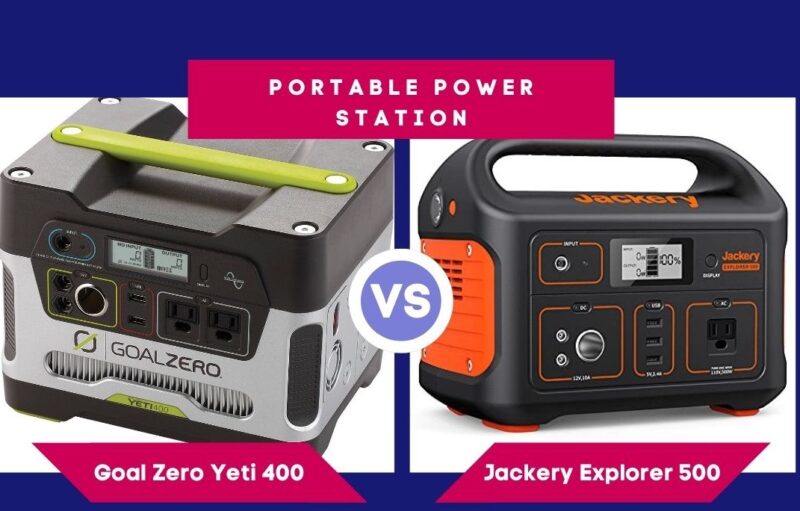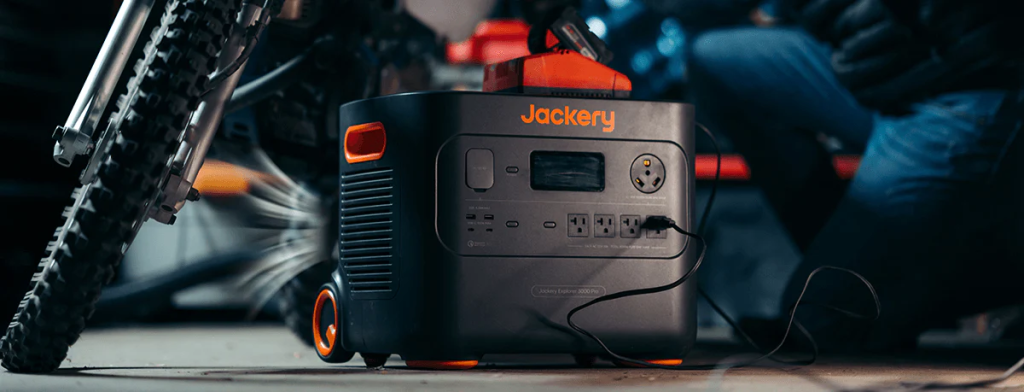We get commissions for purchases made through links in this post. We still remain objective in our reviews though. Thank you for your support!
When we are without our electronic devices for a long time, we often experience a sense of isolation and discomfort. That’s why emergency power sources like the Goal Zero 400 vs Jackery Explorer 500 are so helpful to have on hand when you need electricity away from home.
These portable power stations may charge a laptop or phone battery, as well as a radio, mini-fridge, hairdryer, and more. Since solar panels can recharge them, they’re also ideal for camping excursions, long road trips, tailgating events, and beach days.
If you are thinking about purchasing a portable power station, keep reading to learn more about these handy little charging devices.
This article will discuss the similarities and differences between Goal Zero and Jackery – the two best portable power generator products globally. We’ll look at their features, pros and cons, and more to help you decide which power station is suitable for your needs. A comparison of Goal Zero Yeti 400 vs. Jackery 500 will help you find the perfect option for your outdoor adventures!
In this post, we'll discuss:
What is Goal Zero Yeti 400?
The Goal Zero Yeti 400 is the perfect solution for powering all your devices. It’s equipped with a lead-acid battery and can power up to 7 devices simultaneously. It is lightweight and capable of quick charging/discharging.
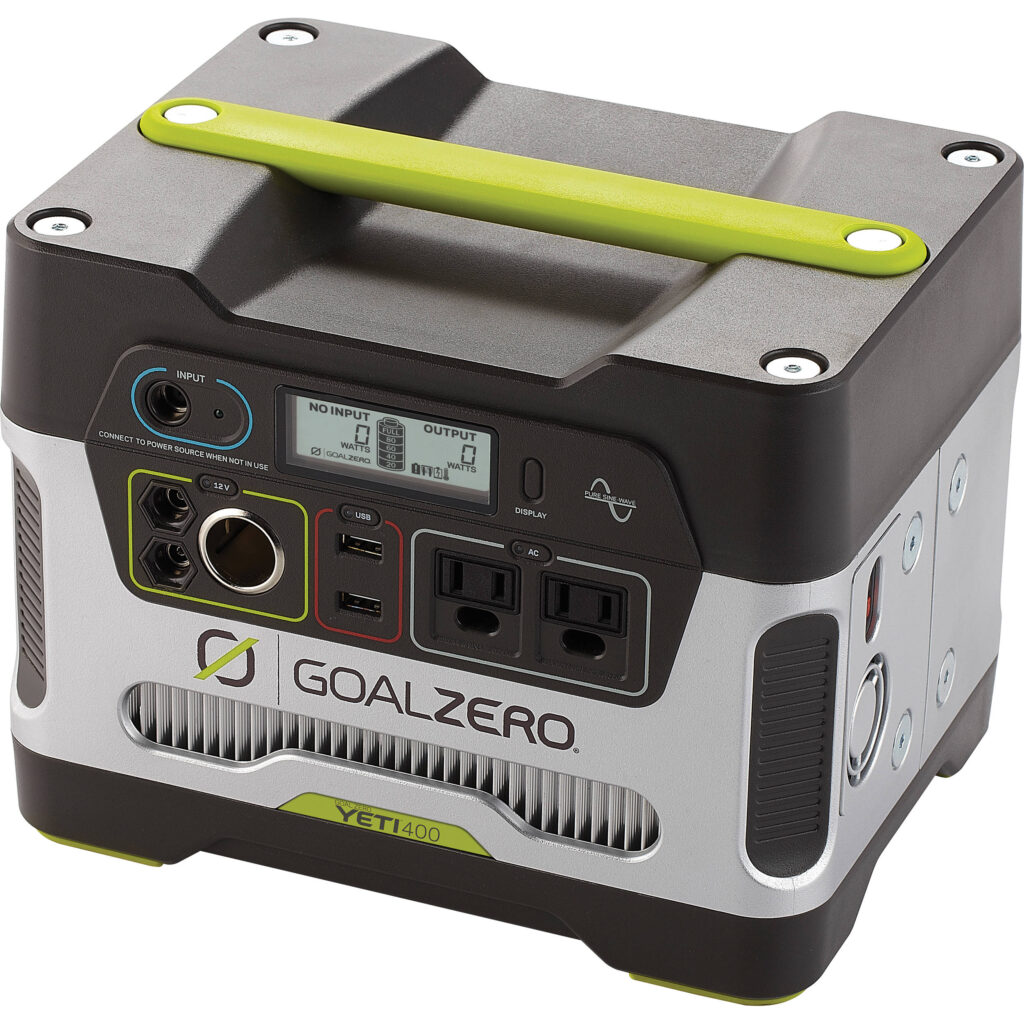
The Goal Zero Yeti 400 is ideal for camping trips or emergencies because you can charge multiple devices at once. It can also be recharged using solar energy panels like Goal Zero Nomad Foldable Solar Panels.
You don’t have to worry about running out of juice when you’re on the go! With Goal Zero Yeti 400, you’ll always be prepared no matter where life takes you! Whether that’s an outdoor adventure or just going through your daily routine, this lead-acid battery-based generator will keep your phone charged so that nothing gets in between you and staying connected! And suppose there’s ever an emergency where electricity isn’t available. In that case, you can simply switch over to AC pure sine wave inverter, which lets you plug into any wall outlet anywhere in the world!
What is Jackery Explorer 500?
Do you need a power station that’s easy to carry around and store?
The Jackery Explorer 500 is the perfect device for anyone who needs a lot of power but doesn’t want to lug around a heavy, bulky generator.
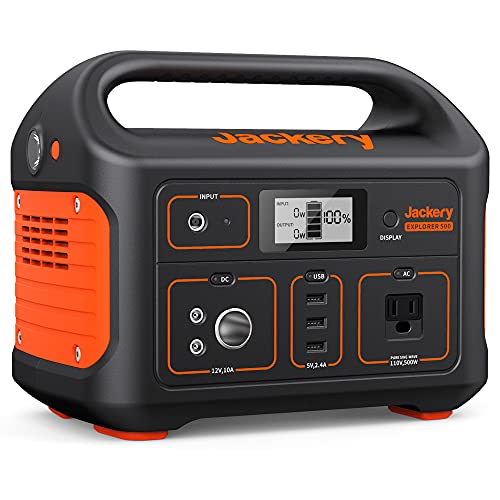
It is light enough to be carried with one arm, making it great for camping trips or other outdoor activities where you’ll need electricity on the go.
Jackery Explorer 500 has a capacity of 518 watt-hours of electricity, making it suitable for most small appliances and electronic devices that you would need to recharge. It also comes equipped with three USB ports, two AC ports, and one 12V port, along with an LED flashlight and a built-in pure sine wave inverter.
This lithium portable power station has an incredible lifespan of 3-6 months before it’s time to recharge! With three USB ports, an AC outlet, and a DC carport, this portable charger can handle all your devices at once! You won’t have any downtime while your Jackery is charging either – just plug in and go about your day as usual.
If an AC port is unavailable to recharge this portable power station, you can connect it to SolarSaga 100 Watt solar panel to replenish it with solar energy.
What are the features of the Goal Zero Yeti 400 that make it better than the Jackery 500?
We tested the Goal Zero Yeti 400 under different conditions, and here’s what we found out:
Design
As far as design is concerned, Goal Zero Yeti 400’s design is simple yet captivating. Standing at 10.25 x 8 x 8 inches and weighing 29 pounds, this product looks like a mini Yeti 1000 Lithium portable power station.
This may seem like a small box to the uninitiated, but for portable power station enthusiasts. It has a durable and robust grip handle situated on top of the pure sine wave power station that supports its weight when being carried.
Every corner is smoothened to prevent injury while carrying this little bad boy on an uneven road. Finally, the black, gray, and yellow color scheme works very well as this product can be easily spotted.
All the ports are conveniently located in one spot. This means that you won’t have a hard time finding the charging port that you need. The solar panel port and the exhaust, on the other hand, are located on the right side.
At the bottom of the power station are four durable rubber padding that protects the power station by absorbing its weight.
Performance
In terms of performance, nothing beats this small power station. It operates quietly and runs at the simple push of a button.
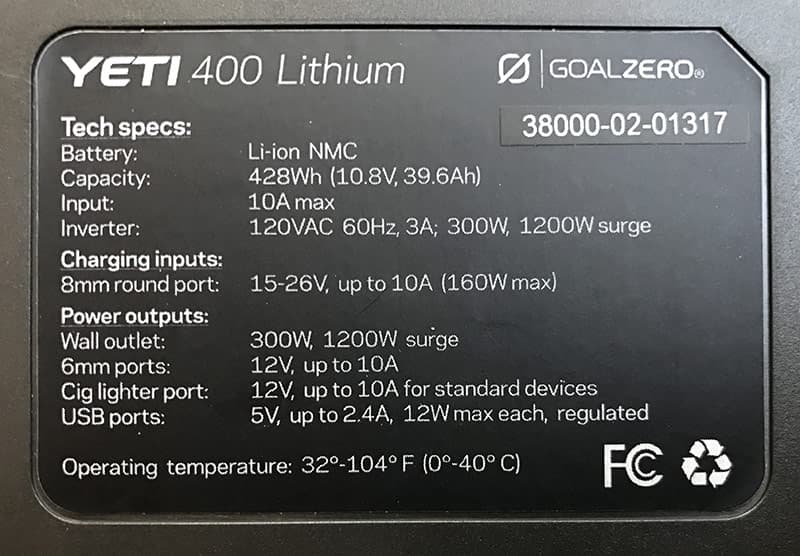
Its lead-acid battery has a capacity of 400Wh, 33Ah (12V). While most power station brands have disposable batteries, this one has a 29-pound chainable and replaceable sealed lead-acid AGM battery.
It has multiple ports, including two USB ports, two AC outlets, and a 12V output. A fully-charged Zero Yeti 400 can power these medium-sized appliances and or multiple smaller devices such as
- Cell phone 20+ Recharges
- Sports camera 70+ Recharges
- LED lamp 70+ Recharges
- Tablets 10+ Recharges
- Laptops 3-5 Recharges
- Light-a-Life 130 Hours
- Mini Fridge 7 Hours
- 32-inch LCD TV 3 hours
Cost/Value
For $449.95, this powerful portable power station can provide your energy needs, whether camping or having an emergency. With a warranty of only 12 months, you may not want to invest in this product if it breaks down after the end of its warranty.
What are the Features of the Jackery Explorer 500 that make it better than the Goal Zero Yeti 400?
We tested the Jackery Explorer 500 under different conditions, and here’s what we found out:
Design
In terms of design, this portable solar power station is very lightweight and portable. Standing at 11.8 x 7.6 x 9.2 inches and weighing only 13.32 pounds, you can carry this power station with one arm!
The color scheme of black and orange is near perfect as it allows you to spot this power station immediately wherever you are. The plastic casing is tough and durable. With the help of its exhaust fan, the container protects the special circuitry inside and prevents it from overheating.
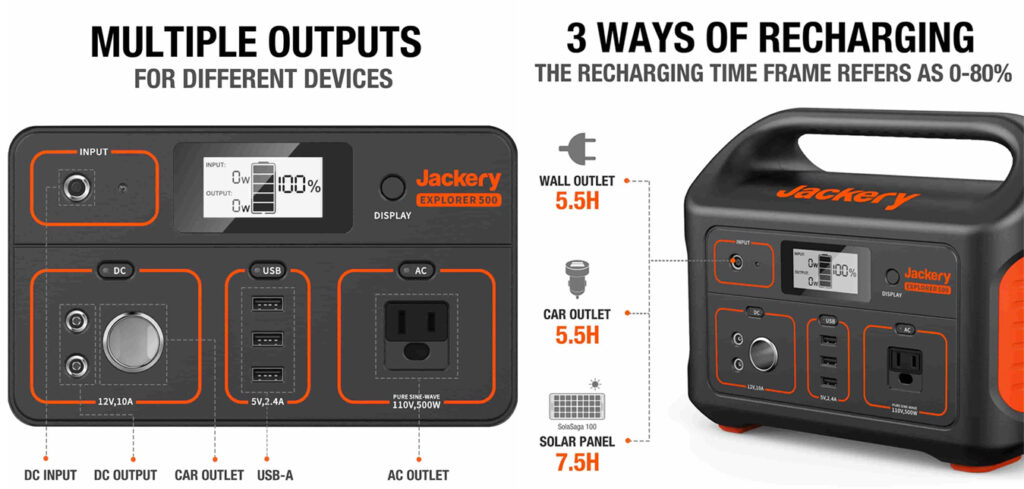
The handle on top of this Jackery portable power station is equally strong and durable. It provides a perfect grip to prevent the power station from falling while being transported by hand.
Meanwhile, the input and output ports such as AC, DC, and USB-A and the LED digital display are conveniently located in one spot, allowing you to connect your devices without hassle.
Finally, the Jackery Explorer 500 is designed to be compatible with SolarSaga 100 watt solar panels for recharging it while on the go. You won’ have to worry about finding wall sockets to charge it when you are camping!
Performance
This portable solar power station has a capacity of 518 watt-hours and can charge several devices at once. It comes equipped with three USB ports, two DC outlets, a 12V carport, and one AC port that you can use to recharge your gadgets and run your small appliances! This makes it great to take on camping trips or other outdoor adventures where electricity is unavailable.
In terms of recharging this portable power station, it takes 7.5 if you plug it on an AC port. It also takes 7.5 hours if you use your 12-volt car charger. However, it would take you 9.5 hours if you use a SolarSaga 100 watt solar panel.
If you are not using this power station, the energy inside its Lithium-ion battery will last up to six months. Therefore, it is recommended to use this product every three to six months to keep it in top shape.
Cost/Value
For $499.99, this power station is worth every penny. The Explorer 500 may be smaller than Yeti 400, but it can certainly deliver the energy you require most, especially during an emergency. Finally, the Jackery 500 has a 24-month warranty, just like its predecessors Jackery 160, 240, and 400.
Pros and Cons of Goal Zero Yeti 400
To continue our Goal Zero vs. Jackery debate, here is a quick rundown of Goal Zero Yeti 400’s pros and cons:
| Pros | Cons |
| Durable, portable, easy to carry Easy to use It has a simple control panel AC outlets: 2 Compatible with most solar panel brands | The solar panel is not included in the package It has only two USB ports Battery is lead-acid 1-year warranty only |
Let’s take a look at how the Goal Zero Yeti 400 might appeal to you.
Pros
First, the design is simple yet functional. It might look like a toolbox, but it is easy on the eyes. You might even mistake this for Zero Yeti 1000 Lithium solar generators.
The ports and digital display are located in one spot. You don’t need to turn this power station around just to plug in your devices and appliances. You only have to look at one place, and you’re done!
Second, the battery capacity is sufficient for small devices and appliances. It might be a little unfair to compare Goal Zero Yeti’s 400 watt-hours to Jackery Explorer’s 500 watt-hours, but it can supply you with backup power when you need it most.
Now, let’s take a look at how this power station might turn you off.
Cons
First is the number of USB ports. There are only two USB ports in this power station. If you have many small gadgets that you need to recharge simultaneously, you might want to pick who goes first.
Next is the battery make-up. If lead-acid batteries are of no concern to you, then you’ll be fine. However, if you are wary of chemicals accidentally spilling everywhere, causing chemical burns, then this product is not for you.
Meanwhile, its heavyweight might turn you off. When you say portable, it automatically means lightweight. At 29 pounds, this product is not lightweight.
The warranty is another potential dealbreaker. If you want to have peace of mind while using this product, a 1-year warranty is too short. What if you encountered an issue while using this product right after its 1-year warranty period expires?
Finally, the solar panel is not included in the package. This is understandable since most tech companies tend to sell parts separately. But if you want to save money, you might find purchasing a solar panel for this power station a little inconvenient.
Pros and Cons of Jackery Explorer 500
To continue our Goal Zero vs. Jackery debate, here is a quick rundown of the pros and cons of Jackery Explorer 500:
| Pros | Cons |
| Durable, portable, lightweight Easy to use It has three USB ports Recharges fast It has a simple control panel Has a battery management system (BMS) Compatible with most 100w solar panel brands | AC outlets: 1 Has no USB c port The solar panel is sold separately |
Let’s take a look at how the Explorer 500 might appeal to you.
Pros
First is the design. At first glance, this may look like the Explorer 1000, but the number of ports will tell it apart. There are three USB ports, two DC ports, and one AC port on this Jackery portable power station – all of which are located in one convenient spot. The digital display provides information about the current battery level.
At 13.32 pounds, portable power stations like this are truly portable. You will not get tired of carrying this product even on rough and uneven roads. The color scheme is also easy on the eyes.
Finally, it has been designed to be compatible with SolarSaga 100w solar panel – Jackery’s official solar panel brand. Suppose you are in the middle of nowhere and there is only the sun. In that case, you can connect this portable solar power generator to your SolarSaga 100w solar panel, and you will have unlimited energy at your disposal!
Now, let us discuss why this Jackery portable power station might disappoint you.
Cons
There is only one AC port on this portable power station. If you need to run two appliances simultaneously, the other one has to wait for its turn. Also, there are no USB-c ports on this product. If you have devices that require USB-c, then you have to use an adapter to recharge them.
Should you buy Goal Zero 400?
If you need a power station that will give your electronics the energy they deserve, then this is an excellent choice. The Goal Zero 400 has been built with those tiny devices in mind and will charge them quickly without compromising quality or output!
It is always a plus when you can charge all your appliances in just one night. That way, they will be ready to go when the next day comes, even if it’s cloudy outside!
The Goal Zero Yeti 400 is the perfect piece of equipment for any prepper, especially those who like to be prepared if there’s an emergency. Not only does this power station keep your devices running, but it can also provide you with clean and renewable energy thanks to solar panels!

Finally, this generator is super quiet, so you can use it just about anywhere.
Should you buy Jackery Explorer 500?
There’s not much to nitpick about with the Jackery Explorer 500, given its features and performance. This lithium battery portable power station outperforms gasoline and propane generators while also outperforming other solar-powered generators on the market. The option for solar panels allows you to get fume-free electricity without causing noise and air pollution, which is a big plus.
The Jackery Explorer 500 portable power station’s incredible lightness makes it ideal for any scenario, so bringing your power pack along will not be a hassle. Five seems plenty in the Explorer 500, with another pure sine wave AC output, but at a reasonable price under $500.
Finally, the Jackery Explorer 500 can supply up to 500 watt-hours of power and provide a feeling of safety and adventure when venturing outside. If you want to stay connected, mobile, and powered up while outdoors, the Jackery Explorer 500 might be helpful.
Frequently Asked Questions
How long will the Zero Yeti 400 last?
In a nutshell, this battery has a six-month shelf life and can survive approximately 500 life cycles before reducing to 80% capacity. The Yeti 400 is capable of keeping a small fridge going for up to 6+ hours.
Do I need to plug the Goal Zero when it’s not in use?
If you have an AC outlet, that is the most excellent option. Not only will this keep the battery fresh, but it can always be used when you need it to be. If your radio is unused for an extended period, make sure you connect it once every 1-3 months to preserve the battery in good condition.
How long does a Goal Zero battery endure?
Batteries have a useful life, which is how long you can use them without being recharged. The lifecycle of a battery (cycle count) is the number of times you recharge its energy over time, e.g., 200-300 for lead-acid and 500-800 for lithium batteries. Yeti Lithium cells are rated at 500-800 cycles.
Yeti 400 Lithium batteries should last for about three months of regular use before they need to be recharged, while the lead-acid version can power devices such as lanterns and portable fridges up to 100 times per charge cycle (if used at 25% capacity or less).
Does Jackery Explorer 500 have USB C ports?
There are no USB C ports available in Jackery Explorer 500. If you have a device that requires this type of port, you can use an adapter to plug it on one of the USB ports.
What happens if the battery of Jackery 500 runs out?
According to Jackery, the company that manufactured this power station, you can plug a 32-inch TV for seven hours or a small car fridge for 39 hours. If you are going to store it after using it, the energy inside its lithium battery will last for three to six months.
If the battery runs out, it will simply be unable to run appliances or charge your favorite gadgets. Simply plug it on an AC outlet or connect it to a 100-watt solar panel to restore its power.
How many years will the Jackery Explorer 500’s battery last?
The Jackery Explorer’s battery has a 500-cycle life expectancy and an 80% capacity. A single battery cycle represents when it decreases from 100 percent to 0 percent and recharges back to 100%. If you go down to 50 percent and then up again, the 500 cycles are 1000 half-cycles.
Conclusion
The Goal Zero Yeti 400 and the Jackery Explorer 500 are great products, but it depends on your personal preferences as to which one would be best for you. If you are looking for something lightweight and very portable, then the Jackery Explorer 500 would be a better choice. If you want to use solar panels with your power station, then Goal Zero’s Yeti 400 might be perfect!
In the end, it all boils down to the exact needs that will lead you to choose the better choice between these two great portable power stations. However, just be sure that you carefully study every Goal Zero vs. Jackery article out there, or else, it will cloud your mind and affect your decision-making process.
Click here if you want to get a Goal Zero Yeti 400!
Click here if you want to get a Jackery Explorer 500!

